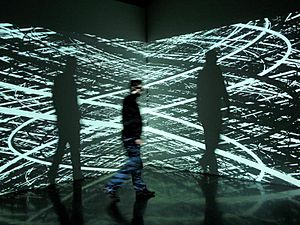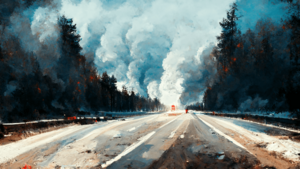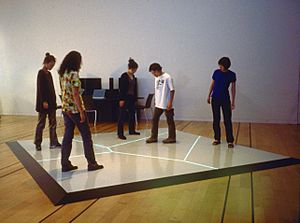Digital art facts for kids
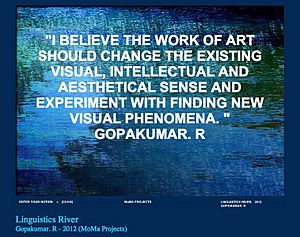
Digital art is any artwork or creative process that uses digital technology. This means using computers, tablets, or other digital tools to make or show art. It's also called computer art, multimedia art, or new media art.
Contents
History of Digital Art
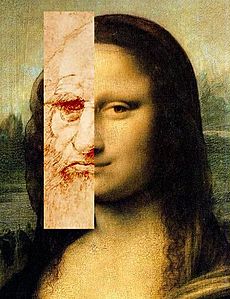
Digital art started becoming popular in the 1960s. John Whitney, a pioneer in computer graphics, made some of the first computer-generated art. He used math to create his art in the early 1960s.
In 1963, Ivan Sutherland invented Sketchpad. This was the first computer program that let users draw directly on a screen.
Later, in 1985, famous artist Andy Warhol created digital art using an Amiga computer. He used a video camera to capture an image of singer Debbie Harry. Then, he used a program called ProPaint to add colors and change the picture.
How Digital Tools Create Art
Digital art can be made entirely by a computer. Examples include fractals and algorithmic art. It can also start from other sources, like a scanned photograph. Artists can also draw images using vector graphics software with a mouse or graphics tablet.
When art is made on a computer using software, but looks like a traditional painting, it's called a digital painting. Artists use digital brushes that act like real paint and tools. Many artists feel that digital technology has opened up "vast" new ways to be creative.
Computer-Generated Visuals
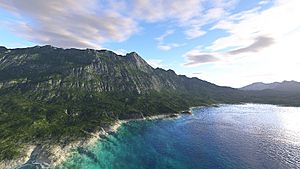
Digital visual art can be 2D (flat) or 3D (like real-world objects).
2D Computer Graphics
This is like drawing with a pencil on paper, but on a computer screen. You might use a tablet pen or a mouse. The picture on your screen can look like it was drawn with a pencil, pen, or even a paintbrush.
3D Computer Graphics
With 3D graphics, your screen becomes a window into a virtual environment. You arrange objects in this virtual world. Then, the computer "photographs" them. This is how many computer-generated images for movies are made.
Algorithmic Art
A third way to make digital art is by using computer programs. These programs follow specific rules, called algorithms, to create art. This is seen as a unique art form for computers. Examples include Fractal art, Datamoshing, algorithmic art, and generative art.
Computer-Generated 3D Still Pictures
3D graphics are made by designing images from shapes like polygons. These shapes create three-dimensional objects and scenes. They are used in movies, TV, games, and special effects.
Many software programs exist for creating 3D art. This technology allows artists to work together. It's similar to how people share and improve things in the open source movement.
Computer-Generated Moving Pictures (Animation)
Computer-generated animations are moving pictures made with a computer. Artists create digital models, or the computer generates them automatically. In the film industry, these are called computer-generated imagery (CGI).
Since the 1990s, CGI has become very advanced. It can now create realistic 3D computer animation. Many modern movies use a lot of realistic CGI to bring stories to life.
Digital Painting
Digital painting is when artists create paintings using computer software. They use a computer or a graphic tablet. Digital brushes in the software can copy traditional painting tools. These include oil paints, acrylics, pastels, charcoal, and airbrush. Artists can also make their own custom brushes.
Artificial Intelligence Art
AI art is made using AI. Artists have used AI to create art since the 1960s.
Since 2014, some artists have used a generative adversarial network (GAN). This is a special type of AI where two "algorithms" compete. They help the computer find the best solution on its own. GANs can create pictures that look like traditional fine art.
How AI Art is Made
Many AI image generators let you describe what you want to see. You can type in details about a scene, characters, weather, or specific items. You can also choose an artist's style or a certain look for the picture.
The AI then creates several pictures based on your description. You can pick the one you like best. Or, you can ask the AI to make new ones. This process makes it much easier for anyone to create art. Artists can also use AI-generated pictures as a starting point. They can then improve them to create new digital paintings.
Awards for AI Art
- In 1991 and 1992, Karl Sims won the Golden Nica award for his 3D AI animated videos.
- In 2009, Eric Millikin won a Pulitzer Prize for his AI art. This art criticized government issues in Detroit.
- In 2018, an AI artwork called "Edmond de Bellamy" sold for US$432,500 at Christie's auction house. It was made by a group called "Obvious."
- In 2022, an amateur artist won first place at the Colorado State Fair using Midjourney AI.
- Also in 2022, Refik Anadol created an AI art installation at the Museum of Modern Art in New York.
Art Made for Digital Media
Digital art also includes visual art made specifically for digital platforms. This art often uses digital tools and relies heavily on computer processes.
Digital Installation Art
Digital installation art is a wide field. It often uses projections and live video. Many digital installations try to create immersive environments. This means they make you feel like you are completely inside the art.
These installations are often made for a specific place. They can also be changed to fit different display areas. For example, Scott Snibbe's "Boundary Functions" draws lines between people as they move. This shows their personal space.
Internet Art and Net.art
Internet art is digital art that uses the special features of the internet. It is shown and experienced online.
Digital Art and Blockchain
Blockchain technology, especially NFTs (Non-Fungible Tokens), is linked to digital art. An NFT is like a digital certificate of ownership for a piece of digital art. When you "mint" a piece of digital art as an NFT, you prove you own that specific digital item.
While this technology has some challenges, many art galleries and museums now work with digital artists. They sell NFTs linked to digital artworks. They also show these artworks in virtual galleries and on screens in real life.
Studying Digital Art
AI is also used to study large collections of digital art. This is possible because many artworks have been made digital. AI can help researchers look at art in new ways.
Two main methods are used:
- Close reading looks at specific visual details of one artwork. AI can help check if an artist really made a piece. It can also analyze brushstrokes.
- Distant viewing looks at similarities across a whole collection. AI can classify artworks or find objects within them.
Digital art helps save history. It can preserve artworks that might otherwise be lost to disasters. However, there are questions about who should own the digital copies of these artworks.
Subtypes of Digital Art
- Art game
- ASCII art
- Chip art
- Computer art scene
- Computer music
- Crypto art
- Cyberarts
- Digital illustration
- Digital imaging
- Digital literature
- Digital painting
- Digital photography
- Digital poetry
- Digital sculpture
- Digital architecture
- Electronic music
- Evolutionary art
- Fractal art
- Generative art
- Generative music
- GIF art
- Immersion (virtual reality)
- Interactive art
- Internet art
- Motion graphics
- Music visualization
- Photo manipulation
- Pixel art
- Render art
- Software art
- Systems art
- Textures
Related Organizations and Events
- Artfutura
- Artmedia
- Austin Museum of Digital Art
- Computer Arts Society
- EVA Conferences
- Los Angeles Center for Digital Art
- Lumen Prize
- onedotzero
- Rhizome
- V&A Digital Futures
See Also
 In Spanish: Arte digital para niños
In Spanish: Arte digital para niños
- Algorithmic art
- Computer art
- Computer graphics
- Electronic art
- Generative art
- Graphic arts
- New media art
- Theatre of Digital Art
- Virtual art


